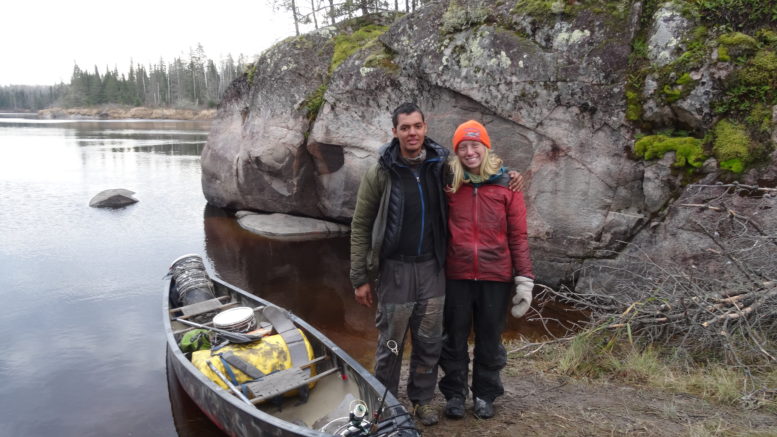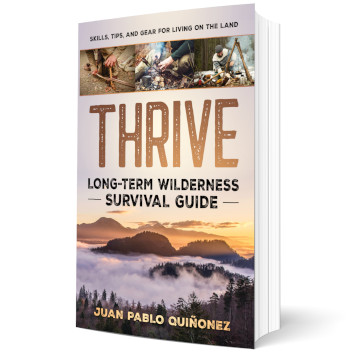These are some of the most important long term survival tips and lessons I learned during my time in the forest.
Group Size
This is one of the most notable lessons from our endeavour. Living in the wilderness is hard work. You have to trap, fish, hunt, gather food, prepare it, and cook it. You also need to start a fire and gather firewood. All these activities are very time consuming.
Some days during berry season, we had to choose how our time would be better spent. Should we paddle to a nearby berry patch and spend the day collecting blue berries? We knew we could maybe gather 8-10 liters of berries in that area. Blueberries contain 51 calories per 100g, so we could possibly gather 2,500 – 3000 calories (enough for 1 person/day). A fish would have been 1000 calories per kg. We had to decide between spending the day fishing or picking berries.
Another time we were sun drying fish strips, and wanted to gather food. But we couldn’t risk leaving the fish at our camp, a bird would eat the strips.
My time in the forest really made me realize the importance of working as a group for survival. We were only two people, and there is only so much that two people can do. The size of your survival group will dictate if you merely survive or thrive.
Technology
When I planned my survival expedition I didn’t pay too much attention to our fishing, trapping, and hunting gear. I figured a fishing pole with some assorted hooks and lures was good enough, I figured a 50 lb recurve bow would be good enough. I assumed we could improvise primitive traps just like our ancestors had done.
The plan was to take some gear, but not too much. I wanted to practice primitive skills and techniques, for they work.
I’ve grown reading about people that highly overestimated and exaggerated their ability to live off the land with minimal gear. We were a little more gradual and cautious in our approach, mostly because of my partner. So we didn’t go full primitive, nor full modern.
After being out there for a month we started to rethink our approach, it was evident that having two fishing poles instead of one could change our fishing capacity. We could have cast twice as much.
It became obvious that primitive traps require lots of time to set up, often need bait, and they could be affected by rain and wind. Not to mention that mice could steal the bait etc.
My Samick recurve bow broke after being strung without a stringer.
What I learned was that the less people you have in your group the more efficient your tools need to be. In other words when you don’t have many hands on deck you have to compensate by having tools and techniques that are highly effective.
Instead of taking one fishing rod I would take two. I’ve bought a more reliable survival bow. If I was going for a year to the wild, I would take assorted conibear traps and a 22 caliber rifle.
Tribes could manage living in the wilderness in a sustainable way with primitive tools; unfortunately, unless you have the numbers, compensating with modern gear is the way to go.
Location
The area where you are will make or break your survival efforts. I spent a lot of time researching the location of my survival expedition. Despite my research, we ended up changing places because we didn’t catch fish in the area we had chosen.
I can’t stress how important the location is. A good location must have:
Access to fish. The grand majority of hunter gatherers were coastal people; the sea is the most abundant source of food, lakes and rivers are the next best thing. Fishing is hands down the best food gathering technique for survival. If you can’t fish, then your area is not the most ideal. Obviously there are alternative foods, but the presence of fish is a great indicator.
Access to water routes or hiking trails that allow for efficient roaming for food. This goes against remoteness and evading other people, but the truth is that you will want a place were you can explore easily.It obviously shouldn’t be accessible to day hikers or motorized vehicles. It should be remote, to avoid competition from other anglers, hunters ,and trappers. But it can’t be an insanely difficult place to roam. You’ll want to gather firewood, harvest wild edibles, trap, and forage in the area, so it should be easy to explore.
Transition zones
Transition zones are the most productive, abundant areas in the wild. An example of a transition zone is the edge of a river, or the end of the forest and start of a prairie. Make sure your location has many transition zones because that’s where the food is.
I would highly recommend researching the hunter-gatherer indigenous groups that inhabited that area to know what were their main sources of food and how they gathered them. Then focus on harvesting that food in the most efficient, but sustainable way possible.
Calories are Everything
In long term survival your main focus after having water and shelter will be food. Most survival instructors on tv have been guilty of showing this: they find some wild edibles or a few grasshoppers and then claim that it’s a meal, and they feel satisfied.
In short-term survival that could be a boost, in long term survival that’s just bait.
The mindset of hunting/trapping a few small game and some wild edibles won’t work. Instead you must ask, how many calories am I spending hunting, trapping, gathering, fishing, and how many calories am I getting? Is this enough to keep me going?
Almost all the survival info out there will tell you to focus on small game, but that’s good advice for 72 hr survival not for long term situations. You would have to hunt over 30 squirrels to fulfill your daily needs.
You must find relatively easy, efficient ways of obtaining lots of calories. If you are not thriving, you must change your strategy.
Wild foods are cyclical and seasonal
When I went to the forest I knew that wild foods are seasonal, but I didn’t know to what extent and how that would affect us. There is a season for tapping Birch trees for syrup, a season for young shoots of cattail, for blueberries, for beaked hazelnuts, for wild rice, and for wapato. It’s easier to hunt grouse in the fall when there is less plants. It’s easier to attract moose when they expect to mate. Beavers are fatter before winter.
It’s all about timing. And it takes experience and observation to know the best timing for each wild edible. For example, we waited for the beaked hazelnuts to become ripe, but by the time we started harvesting the squirrels had eaten most of them.
Wild foods are cyclical, one day you can catch lots and the next day you won’t catch anything, feast and famine. Storms can trigger your traps, and disrupt your trotlines; the weather might be terrible for a few days and animals won’t come out. There will be days when the fish won’t bite.
The season changes and what worked in the past might not work anymore. The fish will change their feeding grounds and they will prefer different bait.
Lack of Energy
Not being well fed will impact every part of your survival plan. The first month in the forest we had a list of projects we wanted to do. By the end of the month we had to cross out the majority of our projects and focus on food gathering.
Tasks that would take you 15 minutes when you are well rested and fed can take you four times longer when you are starving. Everything is harder.
When you don’t reach your daily calorie targets, day after day, you hit the wall. Most marathon runners hit the wall after 3/4 of the race, when their bodies have used most of the energy reserves in their muscles; in survival, the process is similar. After hitting the wall, the body relies mostly on fat for energy, which takes longer to process.
When the body runs only on fat, it works at a much slower pace. You really feel when you hit the wall, it’s as if gravity becomes twice as strong.
You must really try to figure out your food gathering systems, and get enough calories before you hit the wall for too long. It is really hard to get back to feeling energetic after being too long in that “hit the wall” state.
Practice
Because it is so important to be effective and efficient at gathering wild foods I think it’s super important to practice the techniques before hand. That way you can figure out how to improve your techniques and gear. If you are proficient using the techniques you would use on a long term situation then you won’t lose precious time figuring it out.
Training can help you discover blind spots in your strategy as well as as help you be more adequately prepared in terms of equipment.
This one is pretty obvious, but I wanted to emphazise it because after being in the forest I learned so much. Now I have a pretty good idea on how I would do it much better.
Don’t underestimate the Cold
We were in a place where it gets cold during fall, and it hit us hard. Due to a later start of our expedition, our last day moved closer to winter for a few weeks; I was so focused on starting the expedition ASAP that I didn’t adjust our gear for the colder temperatures.
But even weeks before our last day we suffered from the cold. We had lost lots of weight, which insulated us, and our metabolism had slowed down dramatically because it had less energy to work with. We didn’t pack many warm clothes and the sleeping bag I packed was very worn out, so the cold was one of the hardest things we battled.
We had no good mitts or warm shoes so that really drove in the point that good outdoor clothing is the first layer of survival gear and one of the most important ones.
Long Term Survival Tips
These were some of the most recurrent lessons and long term survival tips from our survival expedition. If you like this article, also check out 28 long term survival tips from the alone show.



I would like to see more day/AM/PM nature walks with instructions on seeking out wild edible plants. I have seen many advertised internet in eastern USA and s few in the western USA. We are in North Idaho. I know of one in western Washington in Duvall, Wa., and a few in Arizona and Northern California. However, even this places are too far to travel. I would think more community adult education courses or experiences applicable to the specific locale would be available. Book and color photo learning only goes so far.
Studying what foods / medicines grow in your area naturally is awesome knowledge. When and how to gather and prepare is even more important. Many foods are available year round, other times definitely seasonal. In northern climes, fishing opportunities are reduced if you aren’t able to break through the ice. OTOH, natural refrigeration and much less insects to bother you – some welcome that alone.
Thank you for the post.